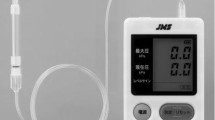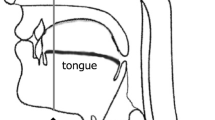Abstract
Tongue pressure is often used to evaluate swallowing muscle strength in dysphagia patients with sarcopenia. However, the amount of tongue pressure that reflects pharyngeal swallowing function is unclear. The aims of this descriptive study were (1) to assess the association between tongue pressure and swallowing function using high-resolution manometry (HRM), (2) to evaluate whether manometric parameters were related to maximum tongue pressure (MTP) and other sarcopenia-related factors, and (3) to evaluate the manometric characteristics of pharyngeal swallowing in sarcopenic dysphagia. Sixteen patients with dysphagia (13 men; mean age 85.0 ± 6.6) who were diagnosed with sarcopenia and sixteen healthy subjects (10 men; mean age 33.6 ± 7.2) were included. Evaluation of HRM parameters including velopharyngeal contractile integral (VPCI), mesohypopharyngeal contractile integral (MHPCI), upper esophageal sphincter (UES) relaxation duration, and UES nadir pressure was performed. HRM parameters of patients were compared with MTP, sarcopenia factors, and manometric parameters of healthy subjects. The VPCI showed no statistically significant differences between patient and healthy groups. In the patient group, the MHPCI was significantly lower (126.1 ± 76.6 vs 193.2 ± 34.1 mmHg cm s; p = 0.003), UES nadir pressure was significantly higher (10.5 ± 27.5 vs − 11.2 ± 6.7 mmHg; p < 0.001), and UES relaxation duration (318.0 ± 152.4 vs 520.6 ± 60.0 ms; p = 0.007) was significantly shorter than those in the healthy group. HRM parameters were not significantly correlated with MTP and sarcopenia factors. Older dysphagia patients with sarcopenia had weaker pharyngeal contractility and UES dysfunction. Manometric evaluation of pharyngeal function may not be significantly associated with MTP and sarcopenia-related factors. Further study is needed to clinically apply tongue pressure for evaluating sarcopenic dysphagia.


Similar content being viewed by others
References
Delmonico MJ, Harris TB, Lee JS, Visser M, Nevitt M, Kritchevsky SB, Tylavsky FA, Newman AB. Alternative definitions of sarcopenia, lower extremity performance, and functional impairment with aging in older men and women. J Am Geriatr Soc. 2007;55:769–74.
Goodpaster BH, Park SW, Harris TB, Kritchevsky SB, Nevitt M, Schwartz AV, Simonsick EM. The loss of skeletal muscle strength, mass, and quality in older adults: the health, aging and body composition study. J Gerontol A. 2006;61:1059–64.
Fujishima I, Fujiu Kurachi M, Arai H, Hyodo M, Kagaya H, Maeda K, Mori T, Nishioka S, Oshima F, Ogawa S, Ueda K, Umezaki T, Wakabayashi H, Yamawaki M, Yoshimura Y. Sarcopenia and dysphagia: position paper by four professional organizations. Geriatr Gerontol Int. 2019;19:91–7.
Wakabayashi H, Sakuma K. Rehabilitation nutrition for sarcopenia with disability: a combination of both rehabilitation and nutrition care management. J Cachexia Sarcopenia Muscle. 2014;5:269–77.
Maeda K, Akagi J. Treatment of sarcopenic dysphagia with rehabilitation and nutritional support: a comprehensive approach. J Acad Nutr Diet. 2016;116:573–7.
Wakabayashi H. Presbyphagia and sarcopenic dysphagia: association between aging, sarcopenia, and deglutition disorders. J Frailty Aging. 2014;3:97–103.
Clavé P, Shaker R. Dysphagia: current reality and scope of the problem. Nat Rev Gastroenterol Hepatol. 2015;12:259–70.
Takashi M, Ichiro F, Hidetaka W, Masataka I, Kenjiro K, Jun K, Shinta N, Akiko S, Yoshitoshi K, Minoru Y, Sumito O. Development, reliability, and validity of a diagnostic algorithm for sarcopenic dysphagia. JCSM Clin Rep. 2017;2:e00017.
Maeda K, Takaki M, Akagi J. Decreased skeletal muscle mass and risk factors of sarcopenic dysphagia: a prospective observational cohort study. J Gerontol A. 2017;72:1290–4.
Bonilha HS, Simpson AN, Ellis C. The one-year attributable cost of post-stroke dysphagia. Dysphagia. 2014;29:545–52.
Altman KW, Yu GP, Schaefer SD. Consequence of dysphagia in the hospitalized patient: impact on prognosis and hospital resources. Arch Otolaryngol Head Neck Surg. 2010;136:784–9.
Cruz-Jentoft AJ, Baeyens JP, Bauer JM, Boirie Y, Cederholm T, Landi F, Martin FC, Michel JP, Rolland Y, Schneider SM, Topinková E, Vandewoude M, Zamboni M, European Working Group on Sarcopenia in Older People. Sarcopenia: European consensus on definition and diagnosis: Report of the European Working Group on Sarcopenia in Older People. Age Ageing. 2010;39:412–23.
Chen LK, Liu LK, Woo J, Assantachai P, Auyeung TW, Bahyah KS, Chou MY, Chen LY, Hsu PS, Krairit O, Lee JS, Lee WJ, Lee Y, Liang CK, Limpawattana P, Lin CS, Peng LN, Satake S, Suzuki T, Won CW, Wu CH, Wu SN, Zhang T, Zeng P, Akishita M, Arai H. Sarcopenia in Asia: consensus report of the Asian Working Group for Sarcopenia. J Am Med Dir Assoc. 2014;15:95–101.
Maeda K, Akagi J. Sarcopenia is an independent risk factor of dysphagia in hospitalized older people. Geriatr Gerontol Int. 2016;16:515–21.
Yoshida M, Kikutani T, Tsuga K, Utanohara Y, Hayashi R, Akagawa Y. Decreased tongue pressure reflects symptom of dysphagia. Dysphagia. 2006;21:61–5.
Ball S, Idel O, Cotton SM, Perry A. Comparison of two methods for measuring tongue pressure during swallowing in people with head and neck cancer. Dysphagia. 2006;21:28–37.
Utanohara Y, Hayashi R, Yoshikawa M, Yoshida M, Tsuga K, Akagawa Y. Standard values of maximum tongue pressure taken using newly developed disposable tongue pressure measurement device. Dysphagia. 2008;23:286–90.
Hirota N, Konaka K, Ono T, Tamine K, Kondo J, Hori K, Yoshimuta Y, Maeda Y, Sakoda S, Naritomi H. Reduced tongue pressure against the hard palate on the paralyzed side during swallowing predicts Dysphagia in patients with acute stroke. Stroke. 2010;41:2982–4.
Knigge MA, Thibeault S. Relationship between tongue base region pressures and vallecular clearance. Dysphagia. 2016;31:391–7.
Minagi Y, Ono T, Hori K, Fujiwara S, Tokuda Y, Murakami K, Maeda Y, Sakoda S, Yokoe M, Mihara M, Mochizuki H. Relationships between dysphagia and tongue pressure during swallowing in Parkinson's disease patients. J Oral Rehabil. 2018;45:459–66.
Sakai K, Nakayama E, Tohara H, Takahashi O, Ohnishi S, Tsuzuki H, Hayata M, Takehisa T, Takehisa Y, Ueda K. Diagnostic accuracy of lip force and tongue strength for sarcopenic dysphagia in older inpatients: a cross-sectional observational study. Clin Nutr. 2018;38:303–9.
Butler SG, Stuart A, Wilhelm E, Rees C, Williamson J, Kritchevsky S. The effects of aspiration status, liquid type, and bolus volume on pharyngeal peak pressure in healthy older adults. Dysphagia. 2011;26:225–31.
Maeda K, Akagi J. Decreased tongue pressure is associated with sarcopenia and sarcopenic dysphagia in the elderly. Dysphagia. 2015;30:80–7.
Nativ-Zeltzer N, Kahrilas PJ, Logemann JA. Manofluorography in the evaluation of oropharyngeal dysphagia. Dysphagia. 2012;27:151–61.
Granger CV, Hamilton BB, Zielezny M, Sherwin FS. Advances in functional assessment in medical rehabilitation. Top Geriatr Rehabil. 1986;1:59–74.
Kunieda K, Ohno T, Fujishima I, Hojo K, Morita T. Reliability and validity of a tool to measure the severity of dysphagia: the food intake LEVEL scale. J Pain Symptom Manag. 2013;46:201–6.
Tohara H, Saitoh E, Mays KA, Kuhlemeier K, Palmer JB. Three tests for predicting aspiration without videofluorography. Dysphagia. 2003;18:126–34.
O'Rourke A, Humphries K, Lazar A. The pharyngeal contractile integral is a useful indicator of pharyngeal swallowing impairment. Neurogastroenterol Motil. 2017;29:e13144.
Omari TI, Miki K, Davidson G, Fraser R, Haslam R, Goldsworthy W, Bakewell M, Dent J. Characterisation of relaxation of the lower oesophageal sphincter in healthy premature infants. Gut. 1997;40:370–5.
Robbins J, Humpal NS, Banaszynski K, Hind J, Rogus-Pulia N. Age-related differences in pressures generated during isometric presses and swallows by healthy adults. Dysphagia. 2016;31:90–6.
Nativ-Zeltzer N, Logemann JA, Zecker SG, Kahrilas PJ. Pressure topography metrics for high-resolution pharyngeal-esophageal manofluorography-a normative study of younger and older adults. Neurogastroenterol Motil. 2016;28:721–31.
Cock C, Omari T. Systematic review of pharyngeal and esophageal manometry in healthy or dysphagic older persons (%3e60 years). Geriatrics. 2018;3:E67.
Dodds WJ, Stewart ET, Logemann JA. Physiology and radiology of the normal oral and pharyngeal phases of swallowing. AJR Am J Roentgenol. 1990;154:953–63.
Shaker R, Easterling C, Kern M, Nitschke T, Massey B, Daniels S, Grande B, Kazandjian M, Dikeman K. Rehabilitation of swallowing by exercise in tube-fed patients with pharyngeal dysphagia secondary to abnormal UES opening. Gastroenterology. 2002;122:1314–21.
Roubenoff R, Hughes VA. Sarcopenia: current concepts. J Gerontol A Biol Sci Med Sci. 2000;55:M716–M724724.
Carmeli E, Coleman R, Reznick AZ. The biochemistry of aging muscle. Exp Gerontol. 2002;37:477–89.
Grelot L, Barillot JC, Bianchi AL. Pharyngeal motoneurones: respiratory-related activity and responses to laryngeal afferents in the decerebrate cat. Exp Brain Res. 1989;78:336–44.
Szczesniak MM, Wu PI, Maclean J, Omari TI, Cook IJ. The critical importance of pharyngeal contractile forces on the validity of intrabolus pressure as a predictor of impaired pharyngo-esophageal junction compliance. Neurogastroenterol Motil. 2018;30:e13374.
Acknowledgement
Thanks to Jun Kayashita who kindly measured the viscosity of the thickened liquid.
Funding
None.
Author information
Authors and Affiliations
Corresponding author
Ethics declarations
Conflict of interest
The authors declare that they have no conflict of interest.
Additional information
Publisher's Note
Springer Nature remains neutral with regard to jurisdictional claims in published maps and institutional affiliations.
Rights and permissions
About this article
Cite this article
Kunieda, K., Fujishima, I., Wakabayashi, H. et al. Relationship Between Tongue Pressure and Pharyngeal Function Assessed Using High-Resolution Manometry in Older Dysphagia Patients with Sarcopenia: A Pilot Study. Dysphagia 36, 33–40 (2021). https://doi.org/10.1007/s00455-020-10095-1
Received:
Accepted:
Published:
Issue Date:
DOI: https://doi.org/10.1007/s00455-020-10095-1




